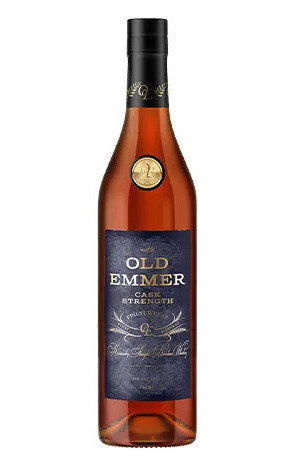
Old Emmer Cask Strength
IJW Distillery (contract distilled by Wilderness Trail in Danville, KY)
116.6
Unknown Wheated Mashbill
On the nose this bourbon has a very delicate aroma. The inclusion of Emmer wheat in the mashbill makes the bourbon have a sweet and soft smell reminiscent of wildflower honey and toasted grain. The wheat really shines through in this mashbill, giving the nose a general earthiness as well.
On the palate, this bourbon is quite the contrary. It’s bold in flavor, greeting you with notes of candied ginger and stone fruit from the wheat. It has an oily consistency that is not often found in wheated bourbons. Finally, it finishes with citrus and sweet oak notes, before fading into a refreshing and lingering finish.
While wheated bourbons such as Makers Mark, Old Fitzgerald, Larceny, and Weller are commonplace on the market; very few distillers choose to distill with “Ancient Grains.” The past five years have shown us that commercial distillers are not afraid to experiment with ancient grains in their mashbills. In 2019, Buffalo Trace released a limited batch of E.H. Taylor distilled with Amaranth (AKA “The Grain of the Gods”) followed by their 2023 release of Daniel Emmer Weller Bourbon (A limited release bourbon under the Weller label that was distilled with Emmer Wheat).
Emmer Wheat or ‘Emmer’ is an ancient grain that can be traced back to Mesopotamia. Emmer was a wild wheat that could be found growing in the fertile crescent (modern day Israel and Iran) and was frequently eaten by the hunters and gatherers that inhabited the area. It was not until 1906 that Aaron Aaronsohn (a Romanian agronomist and botanist) found wild emmer growing Israel and began to study it. To the excitement of botanists, archaeologists later found emmer at dig sites Ohalo II and Netiv Hagdud.
Using carbon dating and radiocarbon dating, archaeologists were able to determine that the emmer found at Ohalo II could be dated to nearly 17,000 BC and Netiv Hagdud to nearly 10,000 BC. This former ‘relic’ has been domesticated so we can grow it in western cultures; however, it is very seldom grown due to poor crop yields. If we fast forward to the present day, emmer is primarily used in genetic research. Being crossbred with the wheats of the present to create a superior product resistant to abiotic and biotic stressors.
Emmer possesses a higher protein and fat content than our “typical” wheat, making it a desirable product to distill. The result is a high-quality mash with unique flavors that you won’t be able to find elsewhere.
So, are you ready for a blast to the past? Don’t worry, we’ve heard they have bourbon there too!